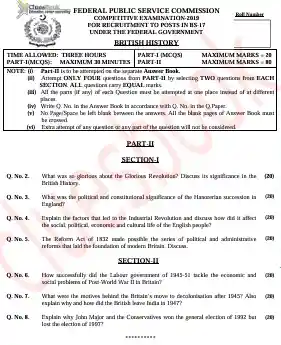CSS Past Papers
Download British History CSS Past Papers 2019 with detailed analysis, structure, preparation advice, and a downloadable PDF. Includes key themes, examiner focus, and topic-wise insights supported by a summary table.

The CSS British History paper (2019) was designed to assess candidates’ understanding of Britain’s constitutional, political, economic, and imperial development. This blog post provides a breakdown of the 2019 paper, helping aspirants focus their preparation on exam trends and high-yield areas.
Overview of 2019 Paper
- Marks: 100
- Time: 3 hours
- Sections: Two sections; attempt four questions in total
- Answering Style: Analytical and well-structured essays
- Use of Sources: Incorporate legislation, historians’ perspectives, and statistical evidence
Thematic Coverage
- Constitutional Reforms: The continuity of representative government and parliamentary acts
- Economic Changes: Industrial Revolution’s impact and policy responses
- Foreign Affairs & Empire: Irish Question, colonial administration, and global influence
- Welfare State Foundations: War economies, social reforms, and post-war adjustments
About the CSS
The CSS (Central Superior Services) Competitive Examination is a rigorous federal-level test administered by the Federal Public Service Commission (FPSC) to select candidates for prestigious civil service roles across Pakistan. The exam’s rules and regulations, covering age limits, eligibility, subjects, and quotas, are detailed in the official CSS Rules section on the FPSC’s website.
The CSS Exam Rules, issued by FPSC Pakistan, outline eligibility criteria, age limits (21–30 years), and a maximum of three attempts for candidates. The exam includes written tests, a medical exam, a psychological assessment, and an interview. Rules also define quotas, disqualification grounds, and subject selection for a fair recruitment process.
Key Themes in CSS British History Paper 2019
| Theme | Sample Focus Area | What Examiner Tested |
| Political & Constitutional Reform | Reform Acts, Parliament Act 1911 | Analytical understanding of political restructuring |
| Economic & Industrial Transition | Factories, trade policies, urban growth | Linking economic changes to social consequences |
| Imperial & Irish Policy | Colonial administration, Home Rule | Balanced argument with critical analysis |
| Social & Welfare Developments | Education Acts, Beveridge foundations | Role of state in improving welfare |
British History CSS Past Papers 2019-Examiner’s Perspective
- Expected depth in arguments rather than broad narratives
- Looked for critical comparison between different eras
- Required historical precision with names, dates, and policies
- Valued balanced viewpoints, especially on empire and Ireland
Preparation Strategy for 2019 Pattern
- Develop topic notes for milestones such as 1688, 1832, 1867, 1911, 1945, 1979
- Practice writing timed answers with clear theses and evidence
- Integrate scholarly perspectives (e.g., Hobsbawm, Colley, Cannadine)
- Avoid overloading with events; focus on causation and consequence
Common Mistakes in 2019 Attempts
- Narrating events instead of analysing their impact
- Ignoring Irish and imperial dimensions
- Weak introductions lacking thesis statements
- Minimal or absent use of Acts/statistics
Recommended Sources
- Books:
- Jeremy Black, A History of the British Isles
- Paul Addison, The Road to 1945
- David Cannadine, Victorious Century
- Documents to Quote: Reform Acts, Beveridge Report, Bill of Rights
Using the 2019 Paper for Practice
- Attempt the questions by drafting outlines first, then writing full essays
- Build a fact repository of 40–50 key dates, Acts, and events
- Compare 2019 questions with earlier years to track recurring themes
Download British History CSS Past Papers 2019
You can download the CSS British History Past Papers 2019 (PDF) from the link below. It is unsolved and intended purely for practice. The 2019 British History CSS paper highlighted the importance of connecting constitutional change, economic shifts, and imperial policy in a single analytical framework.
Use it as a foundation to sharpen your evidence-based approach for future exams.

